2/1/2023
Using Banker Plants to Control Arthropods
Lance S. Osborne, Muhammad Z. Ahmed & Cindy Mckenzie
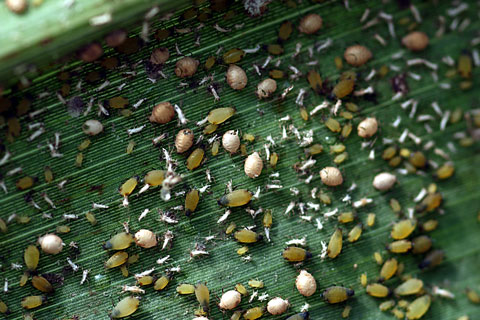
Biological control is only one tool in our pest management arsenal. Its success depends on the other tools that will be used and the availability of beneficial organisms. Biological control using any one of the many available natural enemies will only work if the foundation of the program has been established. The foundation consists of methods to prevent, detect and manage the major pests.
In certain notable cases, there are good and effective natural enemies for the secondary pests. However, experience has shown that reliance on too many natural enemies is complicated and slowly adapted if it’s adapted.
Figure 1. This photo is of healthy and parasitized Rhopalosiphum maidis (Corn leaf aphid) feeding on sorghum. The light tan papery aphids were parasitized by Aphidius colemani.
Growers move to biological controls for many reasons, but a crisis is often the motivation for many of those who have been successful. The crisis is often the loss of effective chemical controls and this usually is for one primary pest (mites, whiteflies, thrips, etc.). As a result, the biological control agents are often forced into existing pest management programs.
In the past, many of the pesticides used precluded integration of these tactics. New chemistry, and in some cases new natural enemies, make this less of an obstacle. With the introduction of the Q-biotype of Bemisia tabaci and perceived problems controlling whiteflies in many crops, the importance of biological control in a resistance management program, which utilize biological control agents, can’t be over-emphasized.
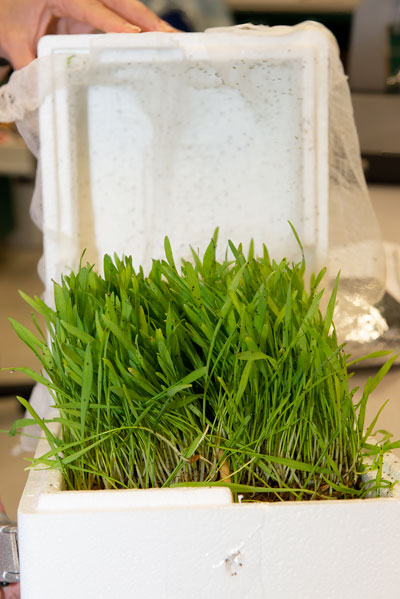
What is a banker plant system?
A banker plant (BP) is a plant that has a population of reproducing natural enemies (NE) on it. This terminology is restrictive and doesn’t allow for the sachets used to produce predatory mites (N. cucumeris, A. swirskii) or the bucket rearing system used to produce parasitoids and predators of mealybugs.
Figure 2. Commercial banker plant system consisting of barley infested with the alternate host, bird-cherry oat aphid.
There are two types of banker plant systems. One system uses the same pest species or crop pest (CP) as the one that’s to be managed; this system obviously possesses a significant risk. The second system provides pollen or a fictitious surrogate or alternate host or prey (AH). This host or AH is reared on plants that aren't grown as a cash crop in the greenhouse where they’ll be used. They should have a limited host range, which doesn’t include the plants being grown
commercially.
• Crop = Plants we’re trying to protect (Examples: Ornamentals, tomato, hemp, pepper, cucumber or herbs)
• CP = Crop pest (The organism that’s the focus of our management program. Examples: Two-spotted spider mite, melon aphid, silverleaf whitefly, thrips.)
• AH = Alternate host. This is an organism that will not establish damaging populations on the crop, but on another easily grown plant that’s of no economic value and would otherwise not be found in proximity to the crop. The AH is also an organism on which our natural enemies will feed and reproduce.
AH examples: Bird-cherry aphid (Rhopalosiphum padi), greenbug (Schizaphis graminum), corn-leaf aphid (Rhopalosiphum maidis), Papaya whitefly (Trialeurodes variabilis Quaintance) or Banks grass mite (Oligonychus pratensis Banks).
• BP = Banker plant (This is the banker plant described above and the plant on which we intend to rear the AH. BP examples: Winter barley or wheat, sorghum, corn, ornamental pepper or papaya.)
• NE = Natural enemy (This is the natural enemy or organism that will feed on both the crop pest (CP) and the alternate host (AH). NE examples: Encarsia transvena, Aphidus colemani, Stethorus spp., Feltiella acarisuga, Scolothrips sexmaculatus, Galendromus occidentalis, Neoseiulus californicus, Amblyseius swirskii or Phytoseiulus persimilis.)
Figure 3. A larva of Diomus austrinus feeding o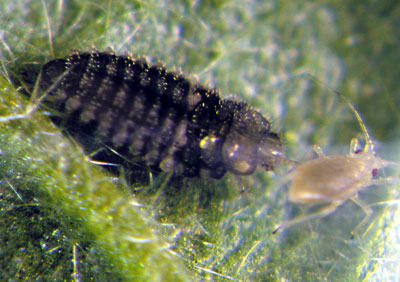 n an aphid. The larva feeds on the aphid by using a leg like a straw to suck the body fluids out of the aphid.
n an aphid. The larva feeds on the aphid by using a leg like a straw to suck the body fluids out of the aphid.
Steps to prepare
• Establish a scouting program.
• Prepare a detailed list of all potential pests and methods for management.
• Prepare a list of chemicals safe to use on the crop.
• Prepare a subset of these chemicals that are relatively safe to the beneficials you intend on using. Contact the various providers of natural enemies for help.
• Find reliable sources for the beneficial organisms and other materials needed.
• A reliable source for guidance is also extremely useful.
Once the foundation is established, the implementation of your plan can begin. Because the release and establishment phase is the most critical and often the most difficult, concentrate on the development of techniques that will help in this phase.
Grower motivation for using banker plants:
• Provide natural enemies not commercially available.
• Provide growers with methods they can use to evaluate the quality of purchased beneficials.
• Increase the probability of establishment.
• Make the use of biological control more economical and reliable.
• Allow for the application of pesticides without totally disrupting biological control programs that are in place.
Aphid systems
Aphid banker plants were one of the first systems to be developed and certainly the first to be commercialized for the ornamental industry. Examples of AHs and BPs are Rhopalosiphum padi (Bird-cherry aphids) feeding on winter barley, Schizaphis graminum (green bug) feeding on winter wheat or Rhopalosiphum maidis (Corn leaf aphid) feeding on sorghum (Figure 1). All these aphids can serve as prey for various predators and parasitoids that attack melon, green peach aphids and a few other pest species.
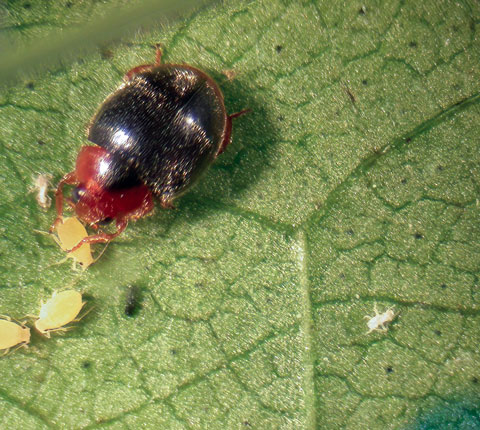 Figure 4. A Diomus austrinus attacking an aphid
Figure 4. A Diomus austrinus attacking an aphid
The success of aphid banker plants has opened the door for interest by the industry to adopt the development and use of this concept for other major pest species. (We’ll present information on systems developed in Florida in future articles.)
The first banker plants to be sold on a commercial scale were probably by IPM Laboratory in 2005. The banker plants were barley infested with the alternate host, bird-cherry oat aphid (Figure 2). The plants supported the natural enemy Aphidius colemani, which is a parasitoid used to control melon and green peach aphids. This company has just released another system where the banker plant is fava bean, the natural enemy is Aphidius ervi and the alternate host is the pea aphid (Acyrthosiphon pisum). This system is aimed at managing the potato and foxglove aphids.
Carol Glenister, the owner of IPM Laboratories, said, “The new system requires more active growing, as the fava bean plants die off quickly from the pea aphid pressure than the barley grass system. Bird-cherry oat aphid only attack grasses and dracaena, while the pea aphids only attack certain legumes, such as fava beans, lupines, alfalfa, peas and sweet peas.”
According to Carol, the two systems allow greenhouse growers to start aphid parasites producing on-site before the crop begins so that any aphids that appear in the crop are picked off immediately. It gives growers a choice to produce their own parasites or buy them regularly.
“Either way, the goal is to have the parasites constantly scouting for and annihilating aphids,” she explained. “The aphid banker plants give the added benefit of constant supply of parasites even when the beneficial insect producers have a crash in their production.
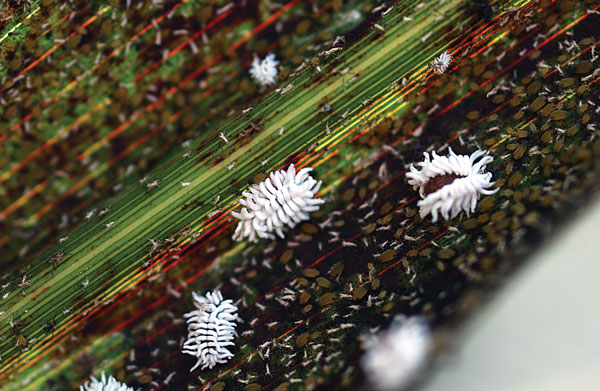 Figure 5. Larvae of the ladybird beetle Scymnus creperus. The larvae look like small mealybugs. Both larvae and adults often naturally infest aphid banker plants in Florida. They’re excellent predators of many species of aphids.
Figure 5. Larvae of the ladybird beetle Scymnus creperus. The larvae look like small mealybugs. Both larvae and adults often naturally infest aphid banker plants in Florida. They’re excellent predators of many species of aphids.
Optimally with aphid banker plants, growers can only find live aphids on the banker plants and the only aphids in the crop are already aphid mummies, having been found and parasitized before we humans could even detect them.”
In Florida, we’ve had issues with relying on these systems. Our primary aphid pest is the melon aphid, which often has populations with predominantly small aphids. These aphids are almost half the size of the “larger” forms. What triggers the production of the smaller forms is unknown.
The problem with this is that the parasitic wasps don’t control them as well as they do the larger forms. Because the parasitoids seem incapable of managing the small aphids and Aphidoletes aphidimyza doesn’t establish in our greenhouses, we had to find a predator that would. We colonized two ladybird beetles, Diomus austrinus (Figures 3 to 4) and Scymnus creperus (Figure 5), that effectively control melon aphids attacking numerous crops we’ve evaluated them in.
In summary, banker plants provide growers with more options for biological control of pests in greenhouses. They can provide a means for rearing natural enemies that aren’t commercially available and they provide growers with a method to evaluate the quality of purchased beneficials. Banker plants increase the probability that beneficials will become established. They’re an economical method of providing a reproducing population of natural enemies. And they also reduce reliance on pesticides and thus insect resistance to applied chemical controls. GT
Funding for this research was provided by the USDA-ARS Floriculture and Nursery Research Initiative.
Lance S. Osborne is with the University of Florida, IFAS and Mid-Florida Research & Education Center. Muhammad Z. Ahmed and Cindy McKenzie are with the USDA-ARS Horticultural Research Laboratory in Fort Pierce, Florida.
For information on banker plants, go HERE or HERE.